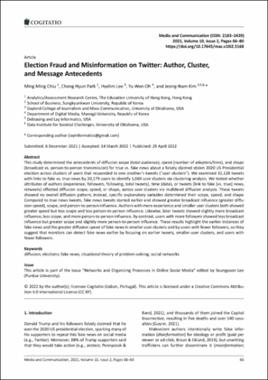| dc.description.abstract | This study determined the antecedents of diffusion scope (total audience), speed (number of adopters/time), and shape (broadcast vs. person-to-person transmission) for true vs. fake news about a falsely claimed stolen 2020 US Presidential election across clusters of users that responded to one another’s tweets (“user clusters”). We examined 31,128 tweets with links to fake vs. true news by 20,179 users to identify 1,069 user clusters via clustering analysis. We tested whether attributes of authors (experience, followers, following, total tweets), time (date), or tweets (link to fake [vs. true] news, retweets) affected diffusion scope, speed, or shape, across user clusters via multilevel diffusion analysis. These tweets showed no overall diffusion pattern; instead, specific explanatory variables determined their scope, speed, and shape. Compared to true news tweets, fake news tweets started earlier and showed greater broadcast influence (greater diffusion speed), scope, and person-to-person influence. Authors with more experience and smaller user clusters both showed greater speed but less scope and less person-to-person influence. Likewise, later tweets showed slightly more broadcast influence, less scope, and more person-to-person influence. By contrast, users with more followers showed less broadcast influence but greater scope and slightly more person-to-person influence. These results highlight the earlier instances of fake news and the greater diffusion speed of fake news in smaller user clusters and by users with fewer followers, so they suggest that monitors can detect fake news earlier by focusing on earlier tweets, smaller user clusters, and users with fewer followers. | en_US |


